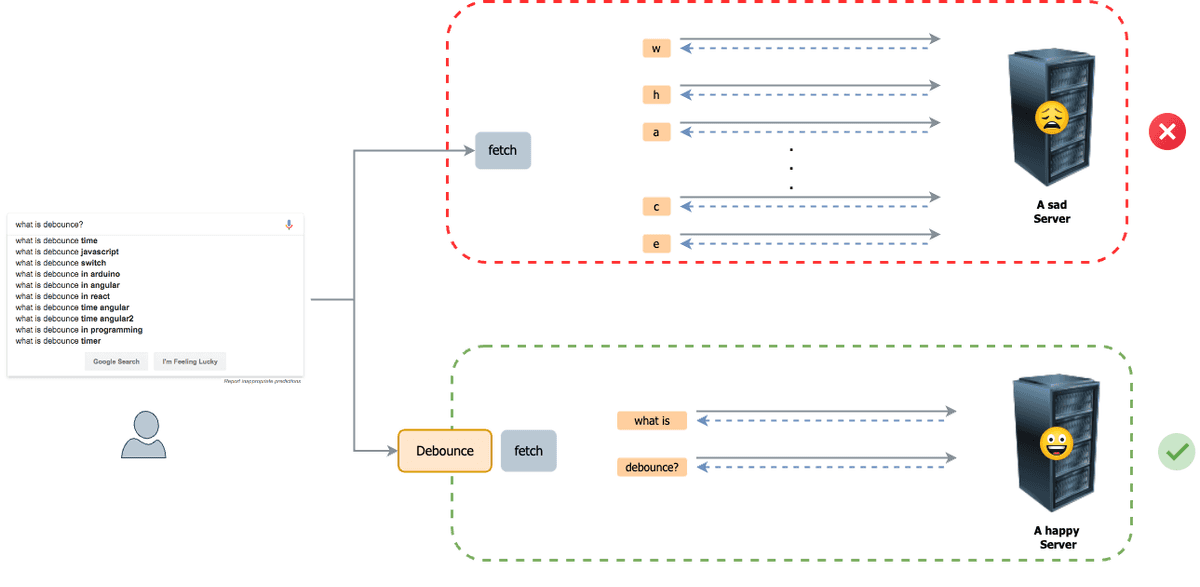Debounce is a pattern to limit the rate at which a function can fire. Its also one of the most frequently asked JavaScript Interview questions, as it requires a deep understanding of JavaScript asynchronous programming and closer.
But why do we want to limit the rate of server calls?
Consider the below situation.

Key Points:
Google search is an interesting case of Debounce pattern. If you are designing this page, you may want to consider the following.
- On every meaningful full keyword, we want to provide autocomplete suggestions to the user.
- Providing suggestions too early, at every keypress, would be meaningless. Also, it will put an unnecessary load on the server.
- Providing it early enough would defeat the purpose of autocomplete suggestions.
Let's build Debounce
Now we know why we would need a Debounce until let's make one.
Pattern Objectives
- Delay the function call.
- Limit the number of function calls.
- Maintain the context (JavaScript thing 😇)
Video Tutorial
Code
Final Debounce
function debounce(func, wait) {let setTimeoutRef;return function (...arg) {const context = this;clearTimeout(setTimeoutRef);setTimeoutRef = setTimeout(() => {func.apply(context, arg)}, wait);}}
Search Component used on Video Tutorial
import React, { useState } from 'react';import { useCallback } from 'react';/*** Agenda:* [x] Delaying a function call* [x] Cancelling a function call, if a new call happens before the wait expired.* [x] Maintaining the Context.*/function debounce(func, wait) {let setTimeoutRef;return function (...arg) {const context = this;clearTimeout(setTimeoutRef);setTimeoutRef = setTimeout(() => {func.apply(context, arg)}, wait);}}function Search() {const [text, setText] = useState();const [smartText, setSmartText] = useState();const debouncedSmartText = useCallback(debounce(setSmartText, 2000), []);const handleChange = (event) => {const value = event.target.value;setText(value);debouncedSmartText(value);}return (<div><h1>Debounce Search</h1><input type="text" placeholder='Search...' onChange={handleChange} /><h2>Simple Text:</h2><output>{text}</output><h2>Smart Text:</h2><output>{smartText}</output></div>);}export default Search;
Search Class Component used on Video Tutorial
import React from 'react';/*** Agenda:* [x] Delaying a function call* [x] Cancelling a function call, if a new call happens before the wait.* [x] Maintaining the Context.*/function debounce(func, wait) {let setTimeoutRef;return function (...arg) {const context = this;clearTimeout(setTimeoutRef);setTimeoutRef = setTimeout(() => {func.apply(context, arg)}, wait);}}class SearchByClass extends React.Component {constructor(props) {super(props);this.state = {}this.handleChange = this.handleChange.bind(this);this.debouncedHandleSmartText = debounce(this.handleSmartText, 2000);}handleChange(event) {const value = event.target.value;this.handleText(value);this.debouncedHandleSmartText(value);}handleText(text) {this.setState({text})}handleSmartText(text) {console.log('this >> ', this);this.setState({smartText: text})}render() {const { text, smartText } = this.state;return (<div><h1>Debounce Search By Class</h1><input type="text" placeholder='Search...' onChange={this.handleChange} /><h2>Simple Text:</h2><output>{text}</output><h2>Smart Text:</h2><output>{smartText}</output></div>);}}export default SearchByClass;
Summary
Thanks a lot for reading this article. If you liked it or have any suggestions on feedback, please drop a comment on YouTube Video of this article.